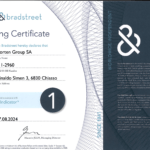Premise
With the e-dec (electronic customs declaration) customs clearance system, the customs declaration agent (in this case the freight forwarder) receives the assessment decision electronically[1]. Customs automatically prepares the assessment decision electronically (Customs decision) and usually prepares it within a few days of import or export. It serves as an import or export certificate and entitles you to a refund of Swiss VAT.
Obligation of the customs declaration officer
It is well known that most importers do not have their own PCD account. In such cases, customs duties and VAT are debited from the PCD account of the customs service provider (freight forwarder, customs agent) and recalculated by the latter to the importer or to the importer. to the principal. Given that paper is abolished with the changeover to the IEA, the supplier of customs services must ensure[2] by another appropriate way that the importer or the supplier of customs services. the principal may withdraw the decisions imposing duty and VAT[3].
Storage needs
In accordance with the VAT Act, the person liable to pay value added tax, usually the importer, is obligedto keep the files related to the VAT[4] and to ensure traceability and verifiability of the entire procedure within his company[5]. This ‘archiving’ includes not only the storage of XML data relating to the Ordinance for ten years, but also the linking of procedures to the respective orders, invoices, etc. within the accounting system[6]. The liability in this case lies solely with the person subject to tax liability (taxpayer) and is appropriately regulated by the VAT Actand the Commercial Books Ordinance (OLC). (Spedloggswiss Circular no. 705/2012 – update 709/17).
Legal information
The Customs Administration adds the following legal information to each Die (decision on assessment) file in the footnotes[7]:
VAT electronic assessment decision (EIV):
This tax decision has been notified electronically and is digitally signed. It serves as evidence for the regulatory customs clearance of the goods referred to therein. Below the link https://e-dec-web.ezv.admin.ch/edecZugangscodeGui/ you can download the electronic assessment decision. You need the customs declaration number and access code mentioned above. Electronic assessment decisions must be retained. The taxpayer is obliged to provide evidence for facts resulting in a reduction in tax (previous tax) before the Federal Tax Administration. Clear evidence is the best evidence. The most obvious are the unmodified and electronically archived DIe. Further information on the DIe can be downloaded from the websites www.ezv.admin.ch (DIe In general) and www.estv.admin.ch (electronic archiving).
Electronic assessment decision duty (EID):
This tax decision has been notified electronically and is digitally signed. It serves as evidence for the regulatory customs clearance of the goods referred to therein. Below the link https://e-dec-web.ezv.admin.ch/edecZugangscodeGui/ you can download the electronic assessment decision. You need the customs declaration number and access code mentioned above.
Electronic assessment decisions must be retained.





